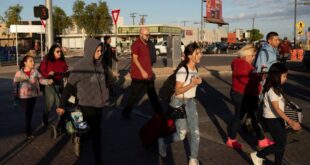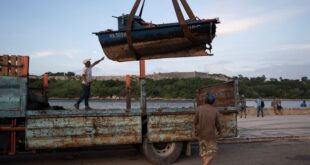SALTILLO, Mexico (Reuters) – On a recent factory shift in the northern Mexican city of Saltillo, Honduran refugee Walter Banegas extracted a steaming-hot piece of molded metal destined for a street lamp from a die-casting machine.
Banegas, 28, said he first fled to the U.S. as a teenager to avoid being recruited by a powerful drug gang, only to be deported in 2014. He re-entered planning to seek asylum in 2020, and was deported again.
So when Banegas fled gang threats in Honduras once more in 2021, he set his sights not on the United States, but Mexico. He was granted refugee status in January and with assistance from a United Nations refugee program, relocated to Saltillo and was paired with a job at Pace Industries, a Michigan-based metal casting manufacturer with plants in the U.S. and Mexico.
Long known as a country of emigration and transit, Mexico in the last five years has become a destination for a small but growing number of refugees, attracted by a less restrictive asylum system than in the U.S. as well as plentiful jobs due to the country’s labor shortage.
Banegas said he is earning about $800 a month at Pace Industries – less than he thought he would make in the U.S. but enough to send at least $50 a month home to his family. He gets along with his Mexican coworkers, he said, and he’s proud his six-month-old son, David, is a Mexican citizen.
“I feel at peace here,” he said. “It’s not necessary to go to the United States. You can also get ahead here, in Mexico.”
‘VERY SOLID OPTION’
A decade ago, a few hundred people annually received asylum in Mexico. By 2021, the number rose to 27,000, according to Mexico’s refugee agency. Mexico is on track this year to approve at least 20,000 asylum cases, with most of the arrivals from Honduras, Haiti, Venezuela, El Salvador and Cuba.
The vast majority of migrants who enter Mexico continue north toward the U.S., posing challenges for the Biden administration. The U.S. logged more than 700,000 individual asylum claims last year.
But the head of the U.N. refugee agency (UNHCR) in Mexico, Giovanni Lepri, said Mexico is becoming a “very solid option” for refugees, in part because of its high labor needs.
Mexico has more than one million job openings nationwide, according to business association Coparmex, and employers in the tourism, agricultural, transportation, and manufacturing industries often struggle to find workers.
According to a Coparmex survey of more than 2,500 businesses released in July, 85% of employers in manufacturing report trouble finding workers, more than in any other sector.
Anticipated growth in “nearshoring,” as companies relocate to Mexico to be closer to U.S. customers, could deepen those labor shortages, according to Mexican manufacturing association INDEX.
U.S., Mexican and U.N. officials have called for regional cooperation to help migrants resettle in places such as Mexico, Costa Rica and Colombia, aiming to reduce illegal migration to the U.S.
The migration director for Mexico’s foreign ministry, Arturo Rocha, said the government is focused on expanding work visa programs and linking employers with job-seeking migrants, especially “to leverage nearshoring.”
Mexico is working with Guatemala’s government to bring up to 20,000 workers to Mexico annually, with an aim of eventually expanding the program to Honduras and El Salvador.
Jose Medina Mora, the head of Coparmex, praised the U.N. program that helped Banegas, and urged the Mexican government to expand work visa programs so more migrants can be quickly matched with employers.
“It would help, especially given this reality of job openings that we can’t cover,” he said.
The U.N. program helps refugees relocate from southern Mexico, where most complete their asylum process, to cities in central and northern Mexico, providing cash grants and assistance with job placements and accessing daycare, schools and healthcare. It helped pair 5,500 refugees with a job in 2022, and nearly 3,000 so far this year.
‘COULDN’T ASK FOR MORE’
When Fernando Hernandez, 24, fled Honduras for southern Mexico last year with his partner and young daughter, his plan was to traverse the country as quickly as possible to reach the U.S.
Then he saw social media posts of children drowning in the river at the U.S. border. He imagined two-year-old Kaitlyn getting swept away. And he thought about his mother, who migrated to the U.S. in 2017, living in a trailer park in Texas, forking over most of her salary for rent.
Hernandez decided to seek asylum in Mexico. After it was approved in February, the U.N. helped the family relocate to the northern industrial city of Monterrey and Hernandez began working at a convenience store.
Hernandez quickly learned that there were job openings everywhere, he said. He upgraded to a factory, then became a cook at a P.F. Chang’s restaurant, earning about $225 a week.
“Here we have everything: a house, food and family,” he said. “I couldn’t ask for more.”
(Reporting by Daina Beth Solomon in Mexico City and Laura Gottesdiener in Saltillo; Editing by Christian Plumb and Suzanne Goldenberg)
 BeritaKini.biz Berita Viral Terkini di Malaysia
BeritaKini.biz Berita Viral Terkini di Malaysia





